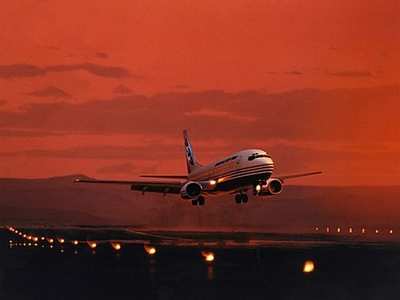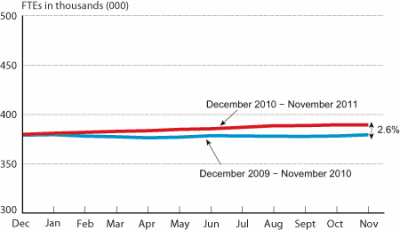BTS Reports 12th Consecutive Increase In Airline FTEs
U.S. scheduled passenger airlines employed 2.6 percent more
workers in November 2011 than they did in November 2010, the U.S.
Department of Transportation's Bureau of Transportation Statistics
(BTS) reported today. This is the 12th consecutive increase in
full-time equivalent employee (FTE) levels for the scheduled
passenger carriers from the same month of the previous year. FTE
calculations count two part-time employees as one full-time
employee.

BTS, a part of the Research and Innovative Technology
Administration, reported that the November FTE total of 389,361 for
the scheduled passenger carriers was 10,026 more than that of
November 2010. This 12th consecutive monthly increase follows
declines that began in July 2008. Historic employment data can be
found on the BTS web site.
Of the network airlines, only Alaska Airlines and Delta Air
Lines decreased employment from November 2010 to November 2011.
Continental Airlines reported 14.7 percent more FTEs in November
2011 than in November 2010, the largest increase among the network
carriers. US Airways followed Continental with a 3.5 percent
increase. Network airlines operate a significant portion of flights
using at least one hub where connections are made for flights to
down-line destinations or spoke cities.
All seven low-cost carriers reported more FTEs in November 2011
than in November 2010, except for Allegiant Air and Frontier
Airlines, which reported a 3.2 percent decrease and a 6.3 percent
decrease, respectively. The low-cost carriers with more reported
FTEs are Virgin America Airlines, Spirit Airlines, JetBlue Airways,
AirTran Airways and Southwest Airlines.

Among the 17 regional carriers, the six carriers reporting
reduced employment levels compared to last year were Horizon
Airlines, Republic Airlines, Comair, Mesaba Airlines, Mesa Airlines
and Colgan Airlines.
Scheduled passenger airline categories include network,
low-cost, regional and other airlines.
The six network airlines employed 67.6 percent of the scheduled
passenger airline total in November, the seven low-cost carriers
employed 17.6 percent and the 17 regional carriers employed 13.6
percent. Delta employed the most FTEs in November among the network
airlines, Southwest employed the most FTEs among low-cost airlines,
and American Eagle Airlines employed the most FTEs among regional
airlines. Five of the top six employers in the industry are network
airlines.
The seven low-cost airlines' FTEs were up 5.9 percent in
November 2011 from November 2010. All low-cost airlines except
Allegiant and Frontier reported year-to-year increases. Those
carriers reporting employment data in both 2007 and 2011 employed
10.8 percent more FTEs in November 2011 than in November
2007. Virgin America reported the largest percentage
increase, up 190.0 percent but Frontier and AirTran reported
declines. Low-cost airlines are those that the industry recognizes
as operating under a low-cost business model, with lower
infrastructure and aircraft operating costs.
The 17 regional airlines' FTEs were up 0.6 percent in November
2011 compared to November 2010. GoJet Airlines and Shuttle America
reported the largest percentage increases. Comair and Colgan
reported the largest percentage decreases. The carriers reporting
employment data in both 2007 and 2011 employed 13.3 percent fewer
FTEs in 2011 than in 2007. Comair reported the largest percentage
decline followed by Mesa and Mesaba Airlines.
The agency also released air fare data for the same period, and
found that passengers are paying more to fly than last year.
Average domestic air fares rose to $361 in the third quarter of
2011, up 6.2 percent from the average fare of $340 in the third
quarter of 2010. Cincinnati had the highest average fare, $488,
while Atlantic City, NJ, had the lowest, $167. The good news is
that the third-quarter fares were 2.4 percent lower than the second
quarter.
BTS says quarter-to-quarter changes may be affected by seasonal
factors.
 Aero-News: Quote of the Day (10.24.25)
Aero-News: Quote of the Day (10.24.25) ANN's Daily Aero-Linx (10.24.25)
ANN's Daily Aero-Linx (10.24.25) NTSB Final Report: Cirrus SR22
NTSB Final Report: Cirrus SR22 Airborne-Flight Training 10.23.25: PanAm Back?, Spirit Cuts, Affordable Expo
Airborne-Flight Training 10.23.25: PanAm Back?, Spirit Cuts, Affordable Expo Airborne 10.22.25: Rez Takes Plane, DJI v US Drone Ban, HK 747 Cargo Accident
Airborne 10.22.25: Rez Takes Plane, DJI v US Drone Ban, HK 747 Cargo Accident




